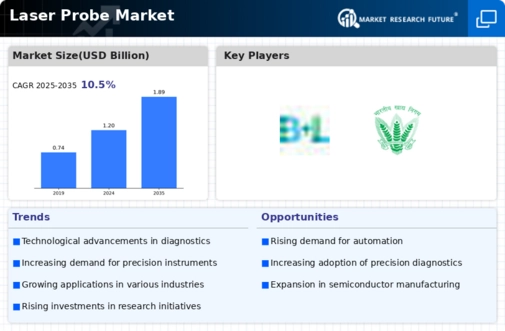Market Trends
Key Emerging Trends in the Laser Probe Market
The laser probe market has been witnessing notable trends and advancements in recent times, driven by the increasing adoption of minimally invasive surgical procedures and the growing demand for advanced medical devices. One significant trend in the laser probe market is the development of innovative laser technologies that offer enhanced precision, efficacy, and safety during surgical procedures. Manufacturers are investing in research and development to introduce laser probes with improved functionality, such as adjustable energy settings, targeted tissue ablation, and real-time feedback mechanisms, to meet the evolving needs of healthcare professionals and patients.
Moreover, there is a rising preference for laser probes that offer versatility and compatibility with multiple surgical applications. Healthcare facilities are seeking laser probes that can be used across a range of specialties, including dermatology, ophthalmology, urology, and gynecology, to maximize cost-effectiveness and operational efficiency. As a result, manufacturers are designing laser probes with interchangeable tips, customizable parameters, and ergonomic designs to accommodate various surgical requirements and preferences.
Additionally, the laser probe market is witnessing increasing demand for portable and handheld devices that offer greater mobility and flexibility in clinical settings. Healthcare providers are seeking compact and lightweight laser probes that can be easily maneuvered during procedures, particularly in ambulatory care settings and outpatient clinics. This trend towards portable laser probes is driving innovation in miniaturization and battery technology, enabling the development of smaller and more ergonomic devices without compromising performance or functionality.
Furthermore, there is a growing focus on the integration of advanced imaging technologies with laser probes to improve visualization and guidance during surgical procedures. Manufacturers are incorporating features such as integrated cameras, optical coherence tomography (OCT), and fluorescence imaging into laser probes to provide real-time imaging feedback and enhance surgical precision and accuracy. These imaging-enhanced laser probes enable surgeons to visualize target tissues, navigate complex anatomical structures, and monitor treatment outcomes more effectively, leading to improved patient outcomes and reduced procedural risks.
Moreover, the increasing prevalence of chronic diseases and age-related conditions is driving the demand for laser probes for therapeutic applications such as tissue ablation, photocoagulation, and photodynamic therapy. Laser probes are being utilized in the treatment of conditions such as cancer, cardiovascular disease, diabetic retinopathy, and skin disorders, offering minimally invasive alternatives to traditional surgical techniques and improving patient comfort and recovery times. As a result, there is a growing market opportunity for laser probes that can deliver precise and controlled energy delivery while minimizing damage to surrounding tissues.
Lastly, the laser probe market is witnessing growing adoption in emerging markets, driven by increasing healthcare expenditure, improving healthcare infrastructure, and rising awareness about minimally invasive treatment options. Developing countries in Asia, Latin America, and the Middle East are experiencing rapid economic growth and urbanization, leading to an expansion of healthcare services and a growing demand for advanced medical technologies, including laser probes. Manufacturers are tapping into these emerging markets by offering cost-effective and scalable solutions tailored to the needs and preferences of local healthcare providers and patients.





Leave a Comment